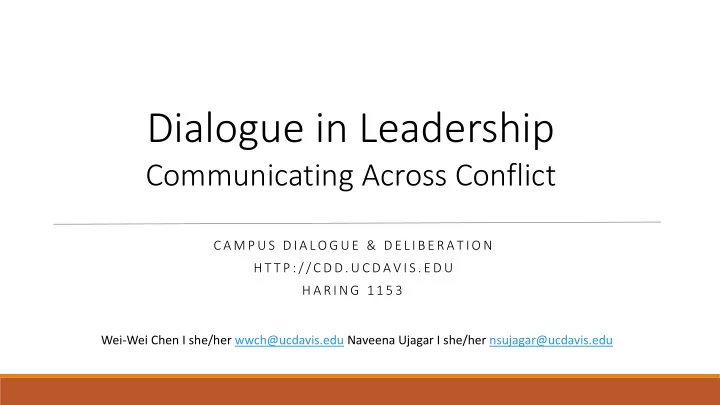

Dialogue in Leadership Communicating Across Conflict C A M P U S D I A L O G U E & D E L I B E R A T I O N H T T P : / / C D D . U C D A V I S . E D U H A R I N G 1 1 5 3 Wei-Wei Chen I she/her wwch@ucdavis.edu Naveena Ujagar I she/her nsujagar@ucdavis.edu
Wei-Wei Chen she/her Naveena S. Ujagar Community & Regional Development B.S. c/o 19 she/her Minors English and Psychology Biomedical Engineering B.S. c/o 20 CDD Student Assistant COE LEADR Dialogue Moderator
What does Campus Dialogue & Deliberation do?
Objectives Understand what dialogue is Learn how to ask strong questions to communicate across conflict Practice applying the questions
Icebreaker • Name • Pronouns • Major • What’s one word you think of when you hear “dialogue”?
What is dialogue?
Hal Saunders "Dialogue is a process of genuine interaction through which human beings listen to each other deeply enough to be changed by what they learn...No participant gives up their identity, but each recognizes enough of the other's valid human claims so that they will act differently toward the other.“ Dr. Harold Saunders, Founder of Sustained Dialogue Institute (SDI)
The Three D’s
Foundation ADAPTED FROM SUSTAINED DIALOGUE INSTITUTE
Identifying Suspension Deep Reflection & Assumptions & of Judgment Listening Inquiry Biases • Develop the ability • Be present, • Make assumptions to witness what • use 'I' statements focusing on the known others are saying moment • “Tell me more about without evaluating that” Individual’s Lived Experiences
Dimension Dominant Group Target Group Race & Color White folx, light-skinned folx Minority people of color (POC): Black, Brown, Indigenous, Latinx/Hispanx, Pacific Islander, Middle Eastern, Asian, Multiracial; dark-skinned folx Ethnicity European descent Other ancestral background Sex Men Women and intersex folx Gender Cisgender men and women Trans, non-binary (NB) Big 10+ Sexual Orientation Heterosexual individuals Gay, Lesbian, Bisexual (bi), Asexual (ace), Pansexual (pan), and others Dimensions Class/Socioeconomic Middle-class, wealthy, those with reliably wealthy Working class, low-income, chronically of Social Status (SES) social networks impoverished Citizenship & Legal citizens born in country; those with green Undocumented, refugees, asylees, Identity Nationality cards Immigrants from minority dominant Immigrants from predominantly White countries countries What else? Religion Christian Jewish, Muslim, Hindus, Sikhs, Buddhists, others Disability & Mental Able-bodied folx, neurotypical folx Developmental disability, physical Health disability, those with mental health issues Political Affiliation Those represented by representatives or well- Those excluded from process established lobbying groups; those with access, (gerrymandered areas, convicted felons); knowledge, and time to influence political those without influential representatives or processes lobbying groups Age Young and middle-aged adults Elderly, teenagers, children
Tools WHAT DO YOU THINK ARE QUALITIES OF AN EFFECTIVE LEADER? HOW DOES DIALOGUE FIT IN?
Dialogue in Leadership • Respect your team • Incorporate different perspectives into your work • Celebrate diversity • Challenge your own beliefs • Improve team dynamics • Learn how to have healthy conflicts
“ The s sing ngle bi biggest pr problem i m in n co commu mmunica cation is is the illu illusio ion t that it it has taken p pla lace.” – George Bernard Shaw
Intent vs. Impact A go good r rule o e of thumb: Ask f k for or c clar arif ific ication ion before a e assuming g malintent. Image from https://itmconflictmgmt.com/making-sense-of-conflict/emotions-triggers-and-intent/
2 C’s: Intervening in Tense Conversations • What do you think this 1. Clarify the speaker’s comment to get a sense of means to you? Identifying what what they are actually • How do you think it people don't say can saying be just as important has affected your as hearing what they 2. Change the conversation perspective? are saying. to experiences • What did you think/feel at the time?
As Ask o ope pen-en ended ques estions from a place o e of curiosi sity ty, not s suspicion Example: Someone says they don’t want to vaccinate their child. Immediate response: “What do you mean? That’s ridiculous! Do you know how much of a health risk that is??!!?!” How can you rephrase your response using the 2 C’s?
Application
Four Corners Activity
You can only be successful in society if you work hard enough.
Remember… • Inquire from a place of curiosity, not judgment. • Ask for and share about life experiences that have shaped hopes, concerns, values, and views. • Note uncertainties, gray areas, and complexities for self and others. • Ask and explain about meanings of words, especially if they are charged.
Debrief • What stood out to you from that experience? • When do you see yourself using these tactics as a leader? • How does this connect to socially conscious leadership? • What surprised you? • What do you want to talk further about?
Revisiting our Objectives Understand what dialogue is Learn how to ask strong questions to Questions? communicate across conflict Practice applying the questions Thoughts? Dialogue allows us to seek mutual understanding reassess our earlier assumptions allow ourselves to be changed gain new understandings based on the experiences of others
Stay in Touch Campus Dialogue & Deliberation http://cdd.ucdavis.edu Facebook: https://tinyurl.com/DavisCDD Come find us! Haring 1153 Join our listserv: dialogue_deliberation@ucdavis.edu Naveena Ujagar nsujagar@ucdavis.edu Wei-Wei Chen wwch@ucdavis.edu
Recommend
More recommend